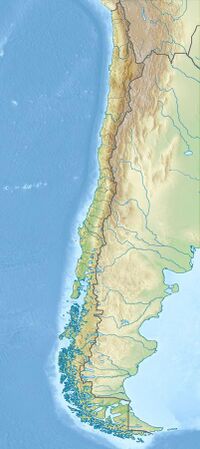Biology:Telmatobius halli
| Telmatobius halli | |
|---|---|
| Scientific classification | |
| Domain: | Eukaryota |
| Kingdom: | Animalia |
| Phylum: | Chordata |
| Class: | Amphibia |
| Order: | Anura |
| Family: | Telmatobiidae |
| Genus: | Telmatobius |
| Species: | T. halli
|
| Binomial name | |
| Telmatobius halli Noble, 1938[2]
| |
Telmatobius halli is a species of frog in the family Telmatobiidae. It is endemic to northern Chile and only known from its type locality near Ollagüe.[1][3] The specific name halli honors Frank Gregory Hall, an American specialist on the effects of high altitudes on human body[4] and collector of the type series.[2] Its common name is Hall's water frog.[1][3][4]
Taxonomy
Multiple phylogenetic studies indicate that this species, the possibly extinct in the wild Telmatobius dankoi, and the possibly extinct Telmatobius vilamensis may all be conspecific with one another.[5][6][7]
Description
The type series includes six adult females measuring 42–57 mm (1.7–2.2 in) in snout–vent length. No males were collected.[2] The head is narrower than the body but broader than it is long. The snout is truncate in dorsal view. No tympanum is present and the supratympanic fold is barely visible. The fingers have rounded tips and no webbing, but have rudimentary lateral fringes. The toes have rounded tips and are extensively webbed. Preserved specimens have uniformly brown to tan The dorsum. There are minute paler specks on the flanks. The venter is pale cream. The finger and toe tips are yellow. Color in life is unknown.[8]
The largest tadpoles are 83 mm (3.3 in) in total length and have long, pointed tails.[2]
Telmatobius halli are strictly aquatic and can survive on land for only five minutes.[9]
Habitat and conservation
Telmatobius halli is only known from its type series,[1] which was collected in 1935 at 3,000 m (10,000 ft) above sea level[2] (contemporary sources give altitude as 3,700 m (12,100 ft)[8] or 2,000–3,400 m (6,600–11,200 ft)[1]). The species was discovered in a small concrete swimming pool created by damming a hot spring.
For many years, a number of searches were conducted, but no new specimens could be found.[1] In 2018, the species was claimed to have been rediscovered by Fibla et al., with their phylogenetic study reassigning the southernmost populations of Telmatobius chusmisensis to T. halli.[7] In 2020, Cuevas et al. claimed to have discovered a Telmatobius halli in a tiny hot spring oasis near Ollagüe in the Atacama Desert.[9] However, Correa (2021) refuted both findings, with both frog populations being distinct taxa from one another and being related to other Telmatobius species, not T. halli. Correa also identified the true type locality of the species as being at Miño, an abandoned mining camp located near the source of the Loa River, where no Telmatobius populations had been described since the original specimens. In late 2020, an expedition to the type locality found a Telmatobius population, which was determined to be T. halli, thus marking the true rediscovery of the species. If T. dankoi and T. vilamensis are in fact conspecific with T. halli, then T. halli may have had a wider range than previously thought.[5]
References
- ↑ 1.0 1.1 1.2 1.3 1.4 1.5 IUCN SSC Amphibian Specialist Group (2015). "Telmatobius halli". IUCN Red List of Threatened Species 2015: e.T21582A79809691. doi:10.2305/IUCN.UK.2015-4.RLTS.T21582A79809691.en. https://www.iucnredlist.org/species/21582/79809691. Retrieved 18 November 2021.
- ↑ 2.0 2.1 2.2 2.3 2.4 Noble, Gladwyn Kingsley (1938). "A new species of frog of the genus Telmatobius from Chile". American Museum Novitates (973): 1–3. http://digitallibrary.amnh.org/handle/2246/3914.
- ↑ 3.0 3.1 Frost, Darrel R. (2018). "Telmatobius halli Noble, 1938". Amphibian Species of the World: an Online Reference. Version 6.0. American Museum of Natural History. http://research.amnh.org/vz/herpetology/amphibia/Amphibia/Anura/Telmatobiidae/Telmatobius/Telmatobius-halli.
- ↑ 4.0 4.1 Beolens, Bo; Watkins, Michael; Grayson, Michael (2013). The Eponym Dictionary of Amphibians. Pelagic Publishing. p. 88. ISBN 978-1-907807-42-8. https://books.google.com/books?id=QJY3BAAAQBAJ&pg=PA88.
- ↑ 5.0 5.1 von Tschirnhaus, Jakob; Correa, Claudio (2021-12-22). "The definitive rediscovery of Telmatobius halli (Anura, Telmatobiidae) at its historic type locality and its synonymy with T. dankoi and T. vilamensis". ZooKeys (1079): 1–33. doi:10.3897/zookeys.1079.69036. ISSN 1313-2970. PMID 35068957. PMC 8716510. https://zookeys.pensoft.net/article/69036/.
- ↑ Sáez, Paola A.; Fibla, Pablo; Correa, Claudio; Sallaberry, Michel; Salinas, Hugo; Veloso, Alberto; Mella, Jorge; Iturra, Patricia et al. (2014-07-24). "A new endemic lineage of the Andean frog genusTelmatobius(Anura, Telmatobiidae) from the western slopes of the central Andes". Zoological Journal of the Linnean Society 171 (4): 769–782. doi:10.1111/zoj.12152. ISSN 0024-4082. https://doi.org/10.1111/zoj.12152.
- ↑ 7.0 7.1 FIBLA, PABLO; SALINAS, HUGO; LOBOS, GABRIEL; POZO, TALÍA DEL; FABRES, ALEJANDRA; MÉNDEZ, MARCO A. (2018-12-03). "Where is the enigmatic Telmatobius halli Noble 1938? Rediscovery and clarification of a frog species not seen for 80 years". Zootaxa 4527 (1): 61–74. doi:10.11646/zootaxa.4527.1.5. ISSN 1175-5334. PMID 30651476. https://doi.org/10.11646/zootaxa.4527.1.5.
- ↑ 8.0 8.1 Formas, J. Ramón; Benavides, Edgar; Cuevas, César (2003). "A new species of Telmatobius (Anura: Leptodactylidae) from Río Vilama, northern Chile, and the redescription of T. halli Noble". Herpetologica 59 (2): 253–270. doi:10.1655/0018-0831(2003)059[0253:ANSOTA2.0.CO;2].
- ↑ 9.0 9.1 Chilean scientists rediscover 'ghost' frog in far-flung desert hot spring
External links
Wikidata ☰ Q2209830 entry
 |



